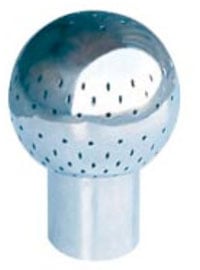A spray ball does a decent job, so what’s the big deal?
If you’re currently using a static spray ball to clean your tanks, you’re probably using a device that has numerous holes through which the wash fluid is released. It relies on the sheer volume of wash fluid and the cascading effect it creates to clean the entire tank surface.

In easy to clean applications, the low impact and high flow rate created by a static spray ball may be adequate. For more difficult residues, this may mean a less effective tank clean.
The flow rate of a spray ball is divided by the number of drilled holes, which means the more holes there are, the lower the flow rate. As the flow rate decreases through any orifice, the impact or mechanical force also decreases, creating a less powerful spray. The spray stream is not only weak but also inexact due to the drill pattern, unable to guarantee a thorough cleaning.
Okay, tell me about rotary jet heads
Rotary jet heads use rotary impingement cleaning to ensure that the entire interior of a vessel is cleaned. By using only two to four nozzles, these tank cleaners ensure the highest impact by concentrating energy into a few very powerful streams.
only two to four nozzles, these tank cleaners ensure the highest impact by concentrating energy into a few very powerful streams.
The nozzles are also designed to follow a 360° pattern that cleans the entire surface in one full cycle. The sheer force of water removes tank residue while the rotation ensures that no part of the vessel surface goes untouched.
Here’s a typical example of how upgrading from static spray balls to rotary jet technology can drastically impact your bottom line.
Before
A personal care company in the US contacted Alfa Laval about improving the tank cleaning process for mixing tanks containing toothpaste residues.
They were using three static spray balls that ran on a two-hour cycle followed by a secondary manual cleaning. The static spray balls operated at a total flow rate of 120 gpm using a pre-rinse, recirculated caustic wash and a final post rinse.
After: Time, water and chemical savings
After installing three Alfa Laval GJ A6 units running at 16 gpm each, the total cleaning time was reduced to a 4 minute pre-rinse, 8 minute caustic wash and 4 minute post rinse, for a grand total 16 minutes. The secondary manual cleaning step was also eliminated. The company was thrilled with the results!
This 80% decrease in time spent tank cleaning allowed the company to significantly reduce their water and chemical usage. They can also use the time they’ve saved on tank cleaning to increase production time.

Are you ready to improve your bottom line? Contact our tank cleaning team for more information.


